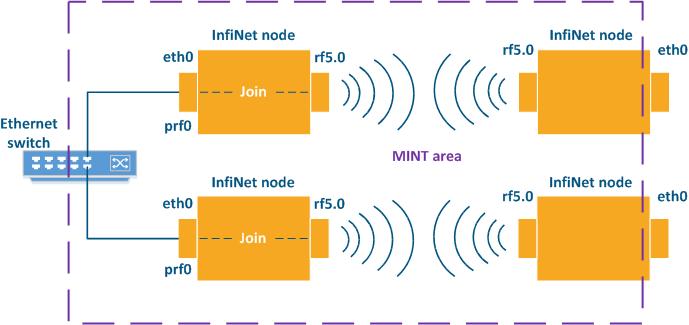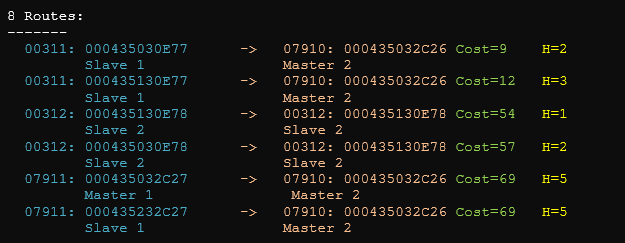| Scroll Ignore | ||||
|---|---|---|---|---|
Content
|
Abbreviations
ACL – Access Control List
ARP – Address Resolution Protocol
CLI – Command Line Interface
DSCP – Differentiated Services Code Point
- HTTP – Hyper Text Transfer Protocol
- IGMP – Internet Group Management Protocol
- IP – Internet Protocol
- MAC – Media Access Control
MINT – Mesh Interconnection Networking Technology
- NAT – Network Address Translation
- OSPF – Open Shortest Path First
- PHY – Physical layer
QoS – Quality of Service
- RIP – Routing Information Protocol
- RSH – Remote Shell
- RSTP – Rapid Spanning Tree Protocol
- SNMP – Simple Network Management Protocol
- STP – Spanning Tree Protocol
TDMA – Time Division Multiple Access
VLAN – Virtual Local Area Network
Introduction
Complex wireless network topologies require enhanced mechanisms to ensure fast packet transfer constantly adapting to the status of the radio connections, especially in cases with mobile objects. The radio link quality changes may lead to different transmission rates from couple of Mbps to hundreds of Mbps for the same link in different conditions. Thus, InfiNet’s proprietary MINT protocols offer an alternative routing method, by taking into account the network topology changes in real time and evaluating the quality of the radio links in real time. In addition to the routing capabilities, MINT includes a set of features that were designed for ensuring an efficient functionality of the InfiNet Wireless units.
This document describes main features of the MINT protocol to ensure deep understanding and, as a result, correct and effective configuration of the MINT network.
Why MINT (Mesh Interconnection Network Technology)?
Initially, the InfiNet Wireless units were developed with IP routing capabilities only, but to solve a number of tasks it was necessary to develop a new solution. Those tasks were:
...
The MINT network can be viewed by the external Ethernet network like one or several virtual Ethernet switches, each having many ports and switching packets from one port to another. However, the mechanisms inside MINT that ensure this behavior are more complex. Next chapter detaily describes main process of the MINT system.
MINT features
MINT areas and interfaces
The radio and pseudo-radio interfaces of an InfiNet Wireless unit are called MINT interfaces. The pseudo-radio interface is a virtual radio interface created over an Ethernet interface.
...
| Center | |||||
|---|---|---|---|---|---|
|
Frame processing
MINT process frames following way:
...
- MINT encapsulates each Ethernet frame by adding its own L2 header. MINT also strips everything that it considers unnecessary from the Ethernet frame – PHS (Payload Header Suppression, through which all headers, including higher layers of the Ethernet frame, are compressed).
- MINT packs smaller frames to bigger superframes (Burst feature) and optionally performs encryption.
- If the Polling based software is used, the whole MINT frames go to the radio sublayer where they are encapsulated to standard 802.11 frames and sent out through a MINT interface.
- If the TDMA based software is used, the MINT frames are converted to time chunks with byte resolution. TDMA adds its own header and sends the data out through a MINT interface.
Automatic MINT nodes discovery
Adjacent neighbor connectivity is needed to create MINT powered link:
...
| Center | |||||
|---|---|---|---|---|---|
|
Link quality assessment
- Each MINT unit has an active full MINT map with all directly connected MINT neighbors and the path selection information (routing table).
- Each MINT node constantly checks the MINT cost with its neighbors (and updates the MINT map).
- Each check is performed every 1-3 s (depending on the node mode).
- The network path can unpredictably change depending on the link quality changes (cost drop).
- Fast new network path selection (MINT parameters can easily accommodate to the rapid changing conditions in the network).
MINT node modes
The time interval for the MINT cost exchanging with the neighboring nodes is adjusted accordingly to the MINT node role. For instance, in case of mobility scenarios, it is necessary to reduce the exchange time interval as the radio conditions change all the time while moving. This improves the reliability, but reduces also the bandwidth available for user data transfer, due to higher service trafic amount.
...
- Fixed - an network infrastructure node with a fixed location. Fixed MINT nodes exchange data every 3 s.
- Nomadic - the physical location of the node might be changed, but the data transfer occurs when the node is not moving (or moving very slowly). Nomadic MINT nodes exchange data every 1.5 s.
- Mobile - the node is likely to move and to exchange data while moving. Mobile MINT nodes exchange data at intervals less than 1 s.
Switch groups
MINT is a proprietary protocol, therefore the data transiting a MINT network needs to be mapped between MINT and Ethernet or any other protocols in order to properly send the information outside the MINT network.
...
- VLANs;
- IP Groups;
- MAC address groups;
- Traffic with the same values for QoS headers fields;
- Multicast traffic;
- A combination of all the above.
Switch Group structure
The Switch Groups have at least one logical interface that can be used as a management interface and two or more interfaces for data traffic. One InfiNet Wireless unit can have several Switch Groups (from 1 to 4095) - for example, different logical channels can be created for different traffic types.
...
The overall behavior of a switch group is similar to a virtual Ethernet switch as stated before, but the inside mechanism for the frame transfer is more complex: for each unit, the switching module is responsible for switching between the external ports and the MINT interfaces, but once the frames are in the MINT network, they will be encapsulated by the MINT header and routed from the source MINT node to the destination MINT node.
Broadcast transmission considerations
The broadcast frames originating from the external network (ARP, for example) are MINT encapsulated and sent only once to every MINT node that are part of the switch group that initially filtered the broadcast frame.
Every unit learns which other units have the same switch group configured through the “Switch Group Discovery Protocol” and this can be checked using “mint map swg” as below.
...
The MINT nodes that receive the copy of the broadcast will switch it to the external network if the Ethernet port is included in the switch group, otherwise will drop it.
The broadcast and multicast generated internally by MINT are sent to every node, but the receiving node will not duplicate the frame in order to avoid creating broadcast storms or loops. The internal broadcast and multicast will never be switched to the external network, no matter what are the interfaces included in the switch group, the processing takes place only locally.
Unicast transmission considerations
When a data transfer is initiated between two devices directly connected to the InfiNet Wireless units, an ARP broadcast will be sent from the source device to the destination device in order to find out the destination MAC address. During such a process, the InfiNet Wireless units will learn the MAC addresses of the directly connected devices.
The MAC switch forwarding table of the InfiNet Wireless units contains all the MAC addresses, that are learnt at a specific moment. The MAC addresses are mapped to the Gateway MAC, which represents the MAC address of the MINT interface that initially routes the frame with the specific MAC address into the MINT network.
...
| Note | ||
|---|---|---|
| ||
The traffic is first filtered and switched towards the MINT interfaces on the border between the external network and the MINT network. Afterwards, the MINT routing and encapsulation take place. |
Loop free capability
MINT avoids internall loops by the nature of its operation:
...
- If N units are connected to the same switch, add the Ethernet interface to the switch groups only for one of the units. This way, only one Ethernet interface will communicate with the external network, the other Ethernet interfaces will use the PRF protocol to communicate with the adjacent unit and will not participate in the L2 switching process;
MINT offers an additional feature for avoiding loops. STP has a specific design for the InfiNet units, by blocking switch groups instead of physical ports like in the classical implementation. The advantage of this solution over removing the Ethernet ports from the switch group is that all units connected to the Ethernet switch are allowed to communicate with the external network, avoiding single points of failure.
Warning title CAUTION There are risks in implementing this solution and InfiNet Wireless should be contacted for the practical aspect considerations.
Remote management
MINT protocol enables sending and execution of any CLI command from the local unit to the remote unit in the MINT network, even if control over the remote unit was lost.
Redundancy
By design, the MINT protocol deals with sending data frames via multiple network paths and this capability allows the implementation of redundancy configurations using multiple parallel connections between one endpoint and another.
...

